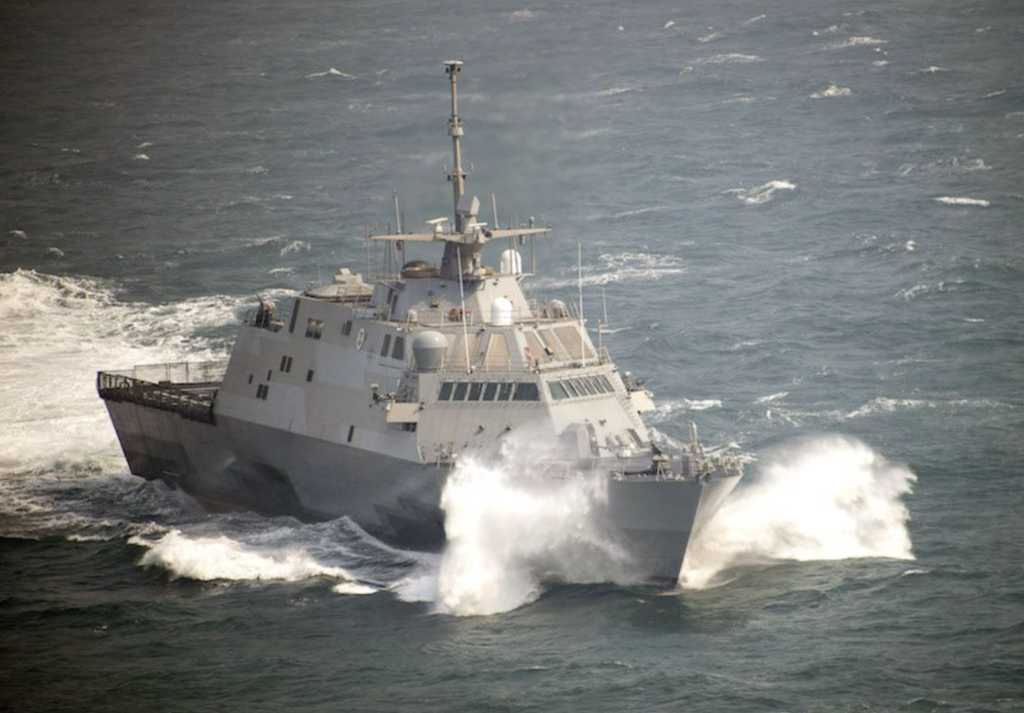Navy Risks Blowback in Bid to Scrap $5 Billion of Troubled Ships

By Tony Capaccio (Bloomberg) –The US Navy wants to scrap nine of 16 Littoral Combat Ships built by Lockheed Martin Corp. well short of their projected service lives in order to save a projected $4.3 billion in upgrades and maintenance over coming years.
That decision may get a hard look at hearings by House and Senate panels on Wednesday and Thursday.
While the ships were built to spend 25 years at sea, many of those on the water are in the infancy of their naval careers. That includes the USS St. Louis, now in its third year of service life; the USS Billings and USS Indianapolis, in their fourth years; and the USS Sioux City and USS Wichita, in their fifth, according to a Navy information paper for Congress obtained by Bloomberg News.
The Navy spent $5 billion in taxpayer money getting the ships built and outfitted. But in justifying the early retirement, the service says eight of the Lockheed-built “Freedom-class” vessels were meant to carry anti-submarine warfare equipment developed by Raytheon Technologies Corp. that failed in development. Promises to give the ships capability for anti-submarine warfare were 12 years late when the plan was abandoned this year.
The vessels are also seen as less capable than the “Independence-class” vessels built by Lockheed shipbuilding rival Austal Ltd. That’s in part because they were hobbled by a latent propulsion system gear defect caused by a subcontractor that requires removal and replacement.
One of the ships being retired, the 12-year-old USS Fort Worth, is a test vessel that is considered no longer necessary.
What Navy leaders originally touted as a 55-vessel fleet of littoral ships costing $220 million apiece has dwindled to a currently planned 35 costing on average $478 million each. The proposed retirement would reduce the overall fleet of LCS — designed to operate in shallow coastal waters — to 26.
The proposal “underscores a chasm between the Navy’s LCS aspirations and actual outcomes,” said Shelby Oakley, an acquisition program director at the Government Accountability Office, who oversees the agency’s naval reports. That gap has only grown since the GAO, beginning in 2005, began reporting on “numerous challenges” in the program and made more than 35 recommendations, she said.
The recommendations “often went unaddressed,” as “the Navy pushed forward, largely undeterred,” she added. “The US taxpayers are left holding the bag with billions of dollars spent on ships that were rarely, if ever, deployed.”
The LCS proposal will be scrutinized by lawmakers as Navy Secretary Carlos Del Toro and other officials testify Wednesday and Thursday on the service’s fiscal 2023 budget, which includes $28 billion for new ship construction. The lawmakers will assess whether the Navy’s move to reduce its inventory of a vessel sometimes derided as the “Little Crappy Ship” is a wise or wasteful initiative.
The LCS retirements are among 24 vessels, including cruisers and dock landing craft, proposed for de-commissioning to help save a total of about $7 billion. That includes eight vessels already operating beyond their expected service life. The decommissioning would contribute to a reduction of the Navy’s total fleet from 298 deployable ships to 280 by 2027, even as the Biden administration is under pressure to boost shipbuilding to counter China.
While some lawmakers will back the move, others will see it as the latest symbol of wasted defense dollars in an era when the White House is seeking $773 billion for the Pentagon in fiscal 2023.
‘More Survivable’
Defense Secretary Lloyd Austin has said he’s confident in the analysis underpinning the decision.
The early version of the LCS “did not live up to expectations,” Austin said in response to a question from Democratic Senator Jon Tester of Montana at a hearing last week. “We made the decision that it’d be better to decommission those ships and invest those resources in acquiring capabilities that are more agile and more relevant to the future fight, more survivable.”
Still, the top Republican on the House Armed Services seapower panel, Representative Rob Wittman of Virginia, said “quantity has a quality of its own, and the US Navy has global obligations, including presence, assurance and deterrence missions around the world.”
Lockheed Martin said in a statement that the Bethesda, Maryland-based company is “working closely with the US Navy on the implementation schedule” to install new gears on the remaining Freedom-class vessels. Raytheon spokesman Chris Johnson had no comment on the program.
Senate Armed Services Committee Chairman Jack Reed said in a statement that the LCS program “showed promise when it was first conceived, but the threats the Navy faces have changed.” Reed, a Rhode Island Democrat, said, “Instead of fighting for years and spending tens of billions of dollars to keep the program afloat, the Navy made the difficult choice to retire some of the ships now and free up many more resources in the future.”
Senator Jim Inhofe of Oklahoma, the top Republican on the committee, said the first in a new class of frigates to succeed the LCS won’t be finished until 2026. “With the Chinese Navy steadily climbing to 460 ships by 2030, the unforced errors in Navy shipbuilding must stop, and programs that can scale up must be the priority,” he said.
© 2022 Bloomberg L.P.
